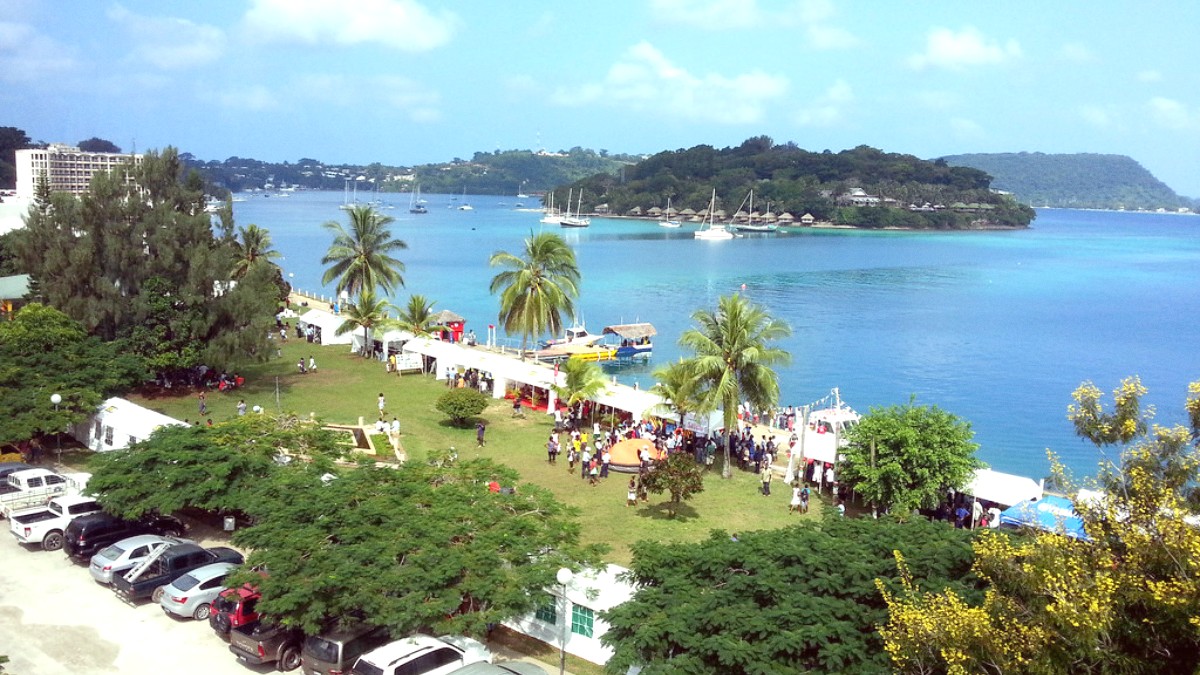
Efate, Vanuatu
The capital city, with its bustling market, diverse dining, and friendly locals, a convenient base for exploring Efate Island, an area full of natural beauty and cultural depth. Experience an authentic Pacific island getaway that invites relaxation and exploration in equal measure.
Port Vila sits on the southwestern coast of Efate Island, a prominent landmass within the Vanuatu archipelago. Efate, the third-largest island in this South Pacific nation, part of Shefa Province. The city itself wraps around a natural harbor, Port Vila Bay, offering sheltered waters and scenic views. Several smaller islands dot the bay and nearby coastlines, including the easily accessible Iririki Island and Ifira Island, which contribute to the area's picturesque setting.
Vanuatu, an independent island nation, stretches across approximately 1,750 kilometers (1,090 miles) east of northern Australia. Efate, like many islands in Vanuatu, formed from volcanic activity, giving it fertile soil and a varied landscape that includes rolling hills, coastal plains, and natural harbors. The island’s geography shapes its climate and natural features, creating a diverse environment for both residents and visitors.
Port Vila's location in the South Pacific positions it as a practical hub for regional travel. Its deep natural harbor facilitated maritime trade and defense historically, and it continues as a port for cruise ships and inter-island vessels today. The surrounding waters boast an abundance of marine life, making snorkeling and diving popular activities.
The coastline around Port Vila and Efate varies from white sandy beaches to rugged volcanic rock formations. This diversity different experiences. Lagoon systems, like Erakor Lagoon, provide calm, sheltered waters ideal for swimming, kayaking, and paddleboarding. These geographical features define the island's appearance and influence the lifestyle of its people.
A unique period in Vanuatu's history unfolded from 1906 with the establishment of the New Hebrides Condominium. This agreement saw the islands jointly administered by two colonial powers: France and the United Kingdom. This dual administration created an unusual system with parallel governmental structures, laws, and even currencies. Port Vila served as the administrative and economic hub during this period. This dual heritage remains visible in Port Vila's architecture, language diversity (English and French are official languages alongside Bislama), and cultural influences.
World War II a pivotal moment for Efate and Port Vila. The island transformed into a significant Allied military base, mainly for American forces, following the attack on Pearl Harbor. Port Vila’s natural harbor and strategic location in the South Pacific it an ideal site for naval facilities, airfields, and supply depots. The influx of foreign currency and goods created opportunities but also disruptions to traditional ways of life.
First European sighting by Pedro Fernandes de Queirós.
Captain James Cook charts the islands, naming them New Hebrides.
New Hebrides Condominium established, shared British and French rule.
Efate becomes a major Allied military base.
Republic of Vanuatu declares independence, Port Vila becomes capital.
Vanuatu’s journey to independence reached its culmination on July 30, 1980, when the Republic of Vanuatu declared. Port Vila proudly became its capital city. This independence marked the end of the unique Condominium arrangement and ushered in a new era of self-governance and national identity for the Ni-Vanuatu people.
The Condominium era's dual British and French administration shaped Port Vila's architecture, language diversity (English and French alongside Bislama), and legal systems.
The presence of American forces during WWII spurred infrastructure development. While many structures were temporary, their economic and social impact was significant, influencing the island's landscape and future.
When visiting the National Museum of Vanuatu, pay close attention to the exhibits on the Condominium era. They offer fascinating insights into this unusual period of dual colonial rule.
These details provide an overview of the country’s demographics, economy, and practical considerations for travelers.
Approximately 50,000 (2020 estimate) in the urban area, Port Vila is Vanuatu's largest city and economic hub.
Bislama (creole), English, and French are official languages. English is common in tourism.
Vanuatu Vatu (VUV). Credit cards widely accepted in resorts, but cash is essential for local markets.
Tourism is a pillar of Port Vila’s economy, drawing visitors with its natural beauty and cultural experiences. The agricultural sector important for the wider Vanuatu economy, with exports like copra, kava, cocoa, and high-quality organic beef.